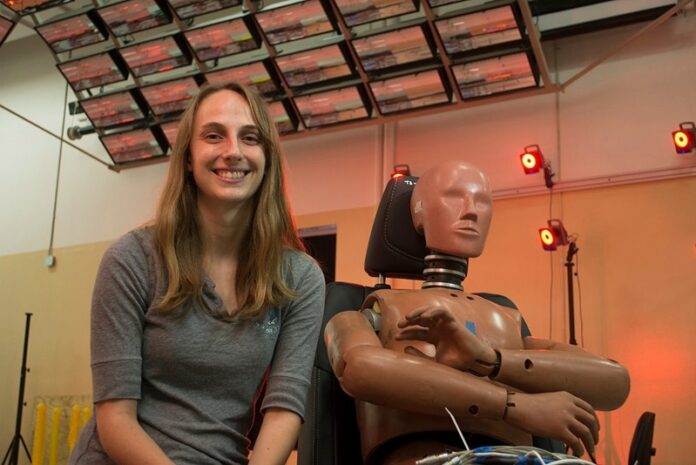
Devon Albert, a fourth-year doctoral student in the department of biomedical engineering and mechanics, at Virginia Tech who spends a lot of her time with a crash-test dummy.
The first prototype of the dummy, which is called THOR for short, was released in the mid-1990s.
“So it’s actually about as old as me,” she said.
THOR, whose name is an acronym for “test device for human occupant restraint,” was designed to replace an older dummy called the Hybrid III. Released in 1976, the Hybrid III is still used today to certify that cars meet government safety standards. The Hybrid III is also used to generate the data behind the familiar five-star vehicle safety ratings.
The newer dummy has a more humanlike spine, shoulders, and chest, among other changes.
But the National Highway Traffic Safety Administration, the federal agency responsible for setting automotive safety standards, can’t use THOR to evaluate vehicle safety until researchers can demonstrate that it’s at least as effective as its predecessor (or more so) at simulating how the human body responds to a car crash.
Albert is one of those researchers.
To test the test dummy, Albert sends a high-tech crash sled through a customized acceleration pattern that mimics a real automotive collision. The latest version of THOR goes along for the ride, and Albert monitors what happens inside and outside its metal-and-rubber body.
Comparing the output to biomechanical data and to the readings generated with the 1976 dummy is critical to determining how accurately THOR reproduces what might happen to a human. This isn’t just an academic exercise: despite improvements in automotive safety, there are still around 90 traffic fatalities every day in the United States, according to the Centers for Disease Control and Prevention.
Albert, who is supported by a Doctoral Scholars Fellowship from the Institute for Critical Technology and Applied Science, got her start in biomechanics as an undergraduate at the University of Pittsburgh, where she researched slip and fall prevention.
Touring prospective graduate schools and looking for a project with a more mechanical slant, Albert visited Virginia Tech. “It was really the research that got me. My first interview was with my current advisor,” said Albert, who works under Andrew Kemper, an assistant professor of biomedical engineering and mechanics in the College of Engineering.
“After that interview, I just thought, ‘I know I’m coming here.’”
In the sled lab, 50 to 60 motion-capture markers distributed over the dummy and the sled help Albert track the dummy’s movement. (The same technology is responsible for the lifelike movements of animated move and video-game characters).
Meanwhile, sensors embedded in the dummy’s body measure internal loads, accelerations, and deflections. Those internal sensors are supplemented by external ones; together they generate between 200 and 300 channels of data in a single experiment. And that’s in addition to the motion-capture data.
Albert doesn’t mind.
“I enjoy the data processing aspect,” she said. “I really like coding, figuring out how to process the data, how to do it efficiently and effectively.”
Albert’s fellowship and her group’s research collaborations have provided plenty of opportunities to travel and share her work, presenting at conferences and visiting labs and companies around the world (most recently, in Belgium). These experiences, she said, have been some of her favorites as a graduate student.
“You kind of get out of your little academic shell and see what else is out there,” she said. “I’ve also been to some pretty cool places.”
Jointly funded by ICTAS, the Graduate School, and the student’s college and department, the Doctoral Scholars program covers tuition, travel funding, and a stipend for four years. The program also encourages students to engage in experiential learning activities, including mentorship and teaching.
Prospective graduate students are nominated by Virginia Tech faculty; faculty should submit nomination packets to their graduate coordinator or associate dean.
In Albert’s case, studying how mechanical forces affect both dummies and the human body requires her to be conversant in a myriad engineering disciplines — not to mention biology. “The body has mechanics, the body has electrical signals, it has cells — so you have to be a jack-of-all-trades,” she sids.
But the reward for taking on the challenge is the chance to make a difference. Albert hopes that ultimately her research will inform government policies on vehicle safety and lead to the design of safer cars.
For now, she is preparing to graduate in the spring, finalizing the reports and manuscripts that will become part of her doctoral dissertation.
So what’s the verdict? Is the THOR a better dummy? Alberts laughs. “Well, the data isn’t completely analyzed yet. So I can’t really speak to that.”

